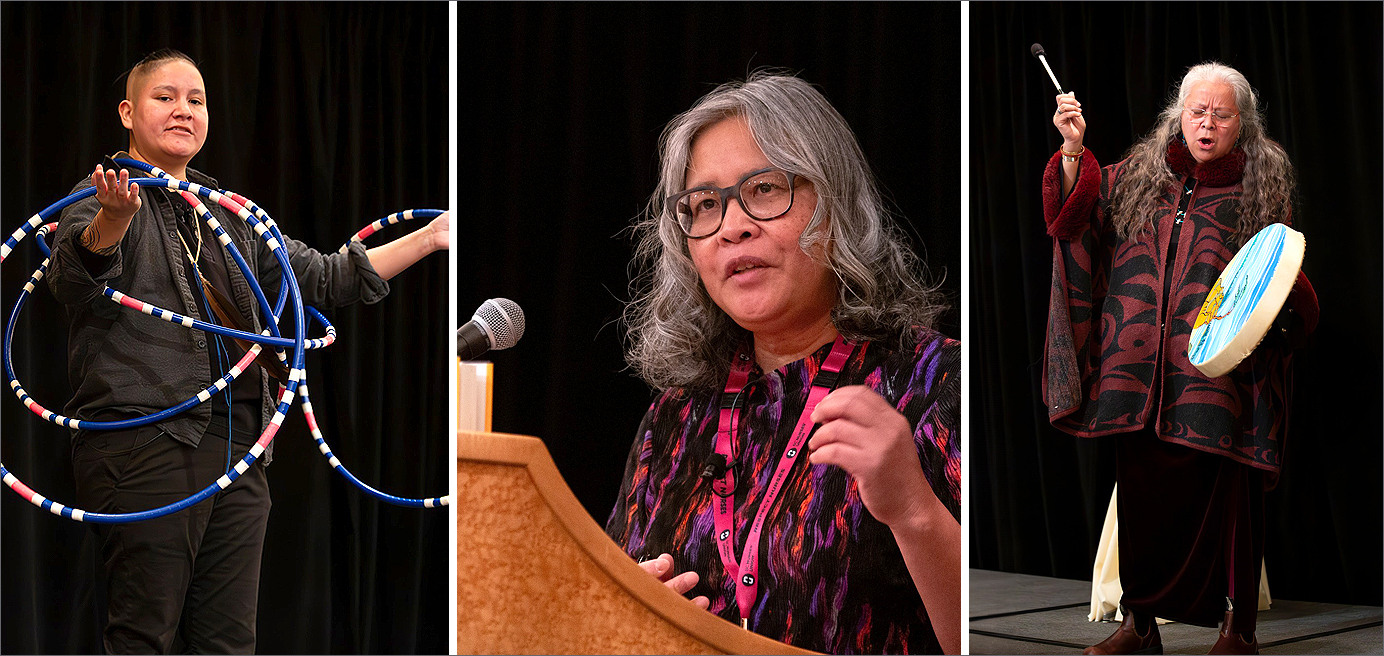 Human Rights and Equity Conference 2023 Highlights
Human Rights and Equity Conference 2023 Highlights

Nurses filled the conference room at the Pan Pacific Hotel on the traditional, ancestral and unceeded lands of the Squamish, Tsleil-Waututh and Musqueam peoples on Nov. 30 to learn about the power of how understanding the past can create new meaning in the present and reframe the future. Featuring a diverse range of speakers, the 2023 human rights and equity conference delved into memories, personal experiences and workshops that encouraged attendees to reflect on and share their personal stories.
The day began with BCNU President Adriane Gear speaking to the power of storytelling in both the nursing profession and everyday life. She called stories “the golden thread that links us, those we love and care about, our past, present and future.”
Gear acknowledged that memories and places hold stories of our past, and though we may only remember a little the lessons stay with us, continuing to inform our decisions and futures.
The opening remarks were rounded out by Gear acknowledging those in attendance, including council members and special quests like Linda Silas, President of the Canadian Federation of Nurses’ Unions (CFNU), and inviting attendees to remain in the moment throughout the day.
The following is a summary of the speakers and presentations that took place on the day.
A Path That Changes You
Connie Paul, who’s Indigenous names are Yetta, Teltitelwet and Hanakim Zim Lisms, weaves storytelling into her nursing practice whenever possible. During her talk, she shared the story of how she came to realize the importance of walking a path through life without judgment for those who need to heal.
Paul, who is of Indigenous ancestry, began her story in her early years living in Richmond and how her young adult life was intertwined with that of a close friend who battled addiction. To help her friend, Paul told the audience that together they sought out the guidance of an Indigenous Elder.
The Elder directed Paul and her friend down a path of enlightenment, where they realized that no matter their decisions up to that point, their lives were worth saving.
“We all have our own stories as nurses,” said Paul. “We all have paths that we chose that inform how we're going to look at that person we're caring for.”
The Bones of Belonging
Annahid Dashtgard has been having conversations about diversity for over 17 years. As the CEO of a justice, equity, diversity and inclusion consulting company, the Iranian-born Canadian activist and author has heard her fair share of stories and has a pretty interesting one of her own.
Fleeing Iran with her family in 1980 during the Iranian revolution , she eventually settled in Canada where Dashtgard said she realized she was an “other” and didn’t belong. It wasn’t until she managed to reconnect with her own life’s story that she unlocked the ability to form that sense of belonging again.
“Knowing our story is our deepest source of power,” Dashtgard told the audience. “Because it gives us clarity to make choices about what we say yes and what we say no to.”
She asked people to think about three things to help them discover their story: context, obstacles and purpose. These, she said, help dig into and understand our stories and allow us to harness their power.
Indigenous Storytelling with Red Buffalo Nova Weipert
Red Buffalo Nova Weipert chose their name, Nova, after looking up a definition at their local library.
“It defined supernova as a star that starts to die, collapses into itself then explodes into the brightest light in the galaxy,” said Nova.
The Anishinaabe Ojibwe transgender and two-spirit interdisciplinary artist detailed their healing journey using the Indigenous tradition of storytelling, weaving a narrative of a childhood spent feeling misunderstood in their small rural Manitoba hometown to where they are today.
Nova, also a hoop dancer, brought hoops on stage explaining the symbolism of each one by one. As they placed each hoop on their body, they explained the values each stands for: love, respect, honesty, humility, courage, truth and wisdom, and how they apply them in their life. Weipert awed conference attendees at the end of their presentation, when they spread wide the hoops they held in the form of the eagle.
Stories that Heal
In the first afternoon presentation, Afro-Canadian novelist Kai Thomas recounted his first childhood memory of meeting his grandmother when he was three years old, and she was still a stranger to him. That status quickly changed with the appearance of her homemade coconut ice cream, which Thomas says he can still taste 30 years later.
“I don’t lie when I say I can still taste it 30 years later,” he said. “It was that good.”
Thomas’s storytelling workshop, titled Re-storying the Past: Stories that Heal, gave conference attendees an opportunity to sit back, listen, think, reflect and share with each other. He explained how meaningful disruptions in our lives are times when we can “re-story” our pasts and re-establish the relationships in life that hold our narratives.
Stories Hold the Cure
Putsata Reang’s afternoon presentation, Stories Hold the Cure, asked attendees to think about the pain they may be holding inside. Reang, a journalist and author of Ma and Me: A Memoir, talked about how stories are the cure to healing the wounds we all carry. “Only when we find the courage to face the pain and go to its edges can we begin to change and live a little bit less encumbered by that hurt,” said Reang.
She shared three stories of her own about stories having an impact, from a nurse friend helping a dying old woman thrive again to how telling her own coming out story saved a college student’s life.
Reang also led a writing exercise during which attendees had seven minutes to answer the question, where does it hurt? Answers included responses about both physical pain and emotional pain.
Reang ended by encouraging nurses to tell their own stories, either in a journal or with a friend, and help shed some of the pain associated with them.
Writing to Change the World
Loung Ung ended the day with a stirring presentation, entitled Writing to Change the World. Ung, a Cambodian-American author, screenwriter, public speaker and activist, spoke about how her own stories of fleeing the Khmer Rouge in Pol Pot’s Cambodia, growing up as a refugee in the whitest state in the US, and what it was like to carry the burden of memories of her trauma with her.
Ung shared how her three books have helped deal with her trauma and reshape the perspective on her family’s history.
While telling her stories, Ung said she also connected strongly to the conference’s theme. She noted that, through storytelling, people can re-story the narratives of the people they love and have lost to remember them for more than just their ending.
“You can write a story with all the senses and add in your third intuition, your goddess, your Gaia, your spirit voice, your faith,” said Ung “Write it so richly and deeply and lively and with life that it now can compete with whatever it was that hurt you,” she said.

